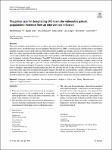Item Infomation
Full metadata record
| DC Field | Value | Language |
|---|---|---|
| dc.contributor.author | Mark, Brennan | - |
| dc.contributor.author | Sophia, Dyer | - |
| dc.contributor.author | Jonas, Jonasson | - |
| dc.date.accessioned | 2023-04-13T02:26:09Z | - |
| dc.date.available | 2023-04-13T02:26:09Z | - |
| dc.date.issued | 2023 | - |
| dc.identifier.uri | https://link.springer.com/article/10.1007/s10729-023-09635-6 | - |
| dc.identifier.uri | https://dlib.phenikaa-uni.edu.vn/handle/PNK/7866 | - |
| dc.description | CC BY | vi |
| dc.description.abstract | This study documents more than five years of analysis that drove the policy case, deployment, and retrospective evaluation for an innovative service model that enables Boston Emergency Medical Services (EMS) to respond quickly and effectively to investigation incidents in an area of heavy need in Boston. These investigation incidents are typically calls for service from passers-by or other third-party callers requesting that Boston EMS check in on individuals, often those who may appear to have an altered mental status or to be unhoused. First, this study reports the pre-intervention analytics in 2017 that built the policy case for service segmentation, a new Community Assistance Team designated “Squad 80” that primarily responds to investigation incidents in one broad area of the city with high rates of substance abuse and homelessness, helping patients who often refuse ambulance transport connect to social services. | vi |
| dc.language.iso | en | vi |
| dc.publisher | Springer | vi |
| dc.subject | Emergency Medical Services | vi |
| dc.subject | vulnerable patient populations | vi |
| dc.title | The policy case for designating EMS teams for vulnerable patient populations Evidence from an intervention in Boston | vi |
| dc.type | Book | vi |
| Appears in Collections | ||
| OER - Kinh tế và Quản lý | ||
Files in This Item:

